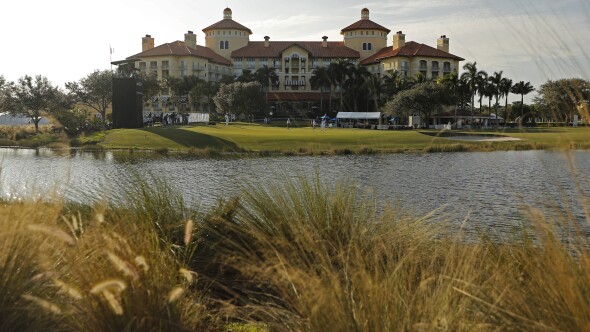GRAND HAVEN, Mich. — There are two big, if not disparate stories about the experience at Michigan's newest golf course, American Dunes.
They can be encapsulated by the dual plaques adorning every hole. At each of the 18 tee boxes, side-by-side stones with engravings display the story of a fallen veteran as well as a story commemorating one of architect Jack Nicklaus' 18 major victories.
I wasn't entirely sure how to process two landmarks of equal weight reflecting highly polarizing events: one of sporting triumph and the other of ultimate sacrifice.
How could the two possibly compare?

Upon later reflection I determined the lesson might be that the achievements of the stone on the right would not be possible without the sacrifices of the fallen soldiers on the left, such as Capt. John E. Tipton, whose story is beside the 2nd hole tee box. The combination of the constant reminder of the sacrifices of military service, in tandem with Jack Nicklaus' newest design that is a stark departure from his other Midwestern layouts, makes for a sensational experience and one that is highly orchestrated down to the finest detail.
American Dunes is a brand-new course on the former Grand Haven Golf Club, which was owned by the family of Folds of Honor founder, Lt. Dan Rooney. It was also the site of his first-ever fundraiser in 2006 that would inspire the annual Patriot Golf Day. The property has been fully transformed following a multi-year reconstruction into a facility where every day will feel patriotic to the max and 100% of annual operating profits will benefit the organization, which provides scholarships to the families of wounded and fallen service members. Nicklaus waived his typical design fee for the privilege of building it.
If you've got red, white and blue golf attire, this is the round to wear it. If you don't, the pro shop has some of the best swag around.

I think about some of the greatest first impressions in golf: arriving at the corner of Golf Place and The Links street in St. Andrews, or pulling up at sunrise at the elevated Mountain Top clubhouse at Big Cedar Lodge in the Ozarks, or walking up the stairs from underneath the Pinehurst clubhouse to see the famed No. 2's 18th green and Payne Stewart hole placement. The welcome at American Dunes is distinctive. After dropping your clubs at the bag drop, you park your car and walk through memorial walls with the bootprints of fallen soldiers beneath you. Once you emerge on the other side at the patio of the clubhouse, the course and giant American flag between the 9th and 18th holes reveal themselves.
It doesn't end there. Much like the military base courses operated by the Department of Defense, American Dunes honors Reveille (morning flag raising) & Retreat (evening flag lowering). Taps is played at 1pm and golfers are asked to stop playing and remove their cap and observe silence until song finishes and the bell rings 13 times. During much of the back nine, a white cross is visible from above the 17th green. When you pass it, you're instructed to toss a nickel under it - an old pilot's tradition.
There are many moments and landmarks to observe and ponder throughout your day here (an email before your visit encourages you to come early and stay late to utilize the practice facility and peruse the memorial and other memorabilia). It's a stimulating and reflective experience and that's before even talking about the golf course itself, one of Nicklaus' most intriguing.
American Dunes: The Course

Michigan golfers familiar with The Bear at Grand Traverse Resort or TPC Michigan are used to a demanding style of 1980s Nicklaus design, a sort of extension from his early design mentor Pete Dye. Those courses, both elite tournament venues in the state, feature challenging angles, aerial approaches, punishing rough and small, intensely guarded green complexes.
To encounter a style more neo-classic in nature at American Dunes was eye-opening. More than 2,000 trees were cleared out from the former tree-lined Grand Haven layout, creating an expansive setting and one where the nearby Lake Michigan breezes swirl around. It takes three holes to get to the really special stuff. The first hole is a mellow and straight par 4 that plays alongside a cemetery. Nos. 2 and 3 are also isolated in their own shady but widened corridor. It's a trek up a hill to the par-3 4th hole that really knocks your socks off and reveals a wide-angle view of a large pocket of holes cresting and tumbling through rugged sand dunes.

From here, fairways snake through sandy blowouts, exposed dunes and small pockets of tall pines. Nicklaus found high ground for numerous elevated tees and left the cart paths unpaved. The shot values are a joy. Fairways are wide and tumbling but clever bunkering and bottle-necking of fairways will make you think before swinging thoughtlessly with the big dog. Short grass surrounds many greens but deep, sandy pits also lurk. There are chances to play safely and funnel approach shots and pitches off slopes to the hole. One of my playing partners utilized the slope left of the par-3 12th hole to kick it down onto the green for a tap-in birdie.

The back nine has a similar, collective expanse of holes from about the 11th green to the 17th, a very strong stretch. Trees make their presence felt mostly on the holes nearest the clubhouse, including the straightaway par-5 18th, a delicious risk-reward finish with a perilously guarded green with water right and bunkers left.
Adding to the neoclassic and welcoming feel is the course's highly walkable, efficient routing. A junior tournament took place the day of our visit and they all had push carts. As we wrapped up our day there, kids were having a putting contest with Old Glory waving above them.

The day before I visited American Dunes I received word my grandmother, a World War II veteran, had passed away at the age of 100. She lived a long, healthy life and got to meet her great grandchildren. Gold Star Families are not as fortunate. Several of these families, also Folds of Honor recipients, appear on your cart's video screen throughout the round in good spirits and thank you for coming and supporting the foundation that is working to better their lives in their fallen loved one's memory.
Throughout the day at American Dunes, I felt a sense of community and joy, which I'd attribute to the detail of the facility, the attitude of the staff and the breezy openness of the layout, which created a communal vibe (highlighted by two very close par-3 greens: the 7th sits just below the par-3 12th). Hoots and hollers of birdies made or big drives smashed echoed throughout the property.
To make an American Dunes tee time, you must submit a request through the contact form on their course website. Green fees are $150 for the public, dropping to $100 October 1 (Active military and veterans pay $100 summer and $75 in the fall). Future plans call for a 1`6-room lodge onsite.

 Back
Back
















